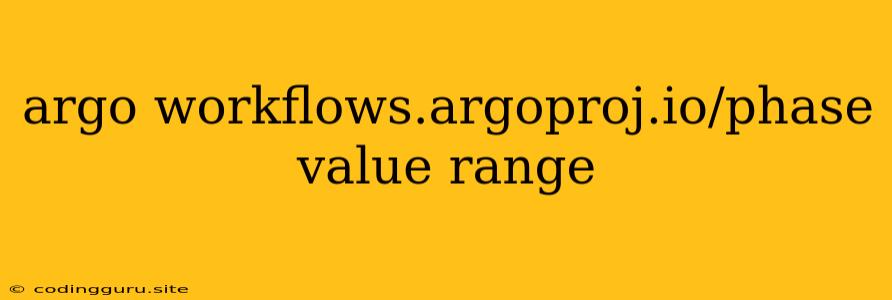Understanding Argo Workflows: Phase Value Range
Argo Workflows is a powerful open-source container-native workflow engine for Kubernetes. It provides a way to define and execute complex workflows composed of multiple steps, each running as a container on Kubernetes. A key concept in Argo Workflows is the phase, which represents the current state of a workflow or a step within it.
What are the Possible Values of the Phase?
The phase of an Argo Workflow or a step can have several possible values, each indicating a specific stage in its execution. These values are crucial for understanding the current status of your workflow and for debugging potential issues. Let's explore these phases:
- Pending: The workflow or step has been submitted but hasn't started yet. This could be due to resource constraints or dependencies.
- Running: The workflow or step is currently executing.
- Succeeded: The workflow or step has completed successfully.
- Failed: The workflow or step has encountered an error and failed to complete.
- Skipped: The workflow or step was skipped, likely due to conditional logic within the workflow.
- Error: The workflow or step has encountered an error during execution, but it's not clear whether it's recoverable or not.
- Unknown: The status of the workflow or step is unknown or unavailable.
How to Use the Phase Value Range
Understanding the phase values is essential for effective workflow management and debugging. You can use this information in several ways:
- Monitoring: Regularly checking the phase of your workflows and steps helps you track their progress and identify any issues early on.
- Debugging: If a workflow or step fails, the phase can provide valuable insights into the cause of the failure. You can then investigate the specific error messages or logs associated with the failed step.
- Automation: You can leverage the phase information in your automation scripts to trigger actions based on workflow state. For example, you could send notifications when a workflow enters the "Succeeded" state.
Example:
Here's a simple example demonstrating the use of the phase value in an Argo Workflow definition:
apiVersion: argoproj.io/v1alpha1
kind: Workflow
metadata:
name: simple-workflow
spec:
entrypoint: main
templates:
- name: main
steps:
- - name: hello
template: hello
- name: hello
container:
image: alpine/hello
command:
- echo
- "Hello, world!"
In this workflow, the "main" template has one step, "hello," which executes the "hello" template. The "hello" template runs a container image that prints a message. You can use the kubectl get workflow command to monitor the phase of the workflow and its steps.
Conclusion
The phase value is an integral part of Argo Workflows, providing a concise way to understand the state of your workflow execution. Understanding these values allows you to effectively monitor, debug, and automate your workflows, ensuring smooth and reliable operations. By leveraging this information effectively, you can maximize the power of Argo Workflows and build robust and scalable applications.
